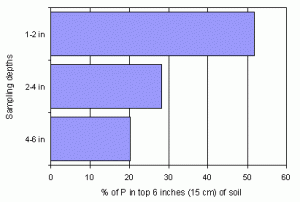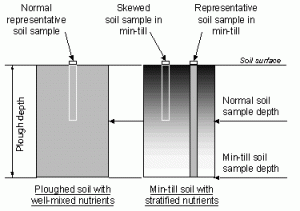Download pdf: Soil sampling and different methods of arable cultivation (329.41K)
pdf 329.41K
Soil sampling and different methods of arable cultivation
December 2009
This article has been updated – follow this link to read the latest version
www.pda.org.uk/soil-sampling-different-methods-of-arable-cultivation/
Soil sampling for the routine measurement of P, K, Mg Indices and pH is familiar to most advisers and farmers. The same well-proven method has been used for many years – 25 cores taken in a ‘W’ or grid pattern across the field to a depth of 15 cm in arable soils. The cores are then bulked before laboratory analysis to determine average field P, K and Mg concentrations.

The 15 cm sampling depth allows easy manual collection of cores and should give results that are representative of the cultivated and mixed soil layer from which the crop extracts much of its nutrient supply. Traditionally, this is the plough layer, which is deeper than the soil sampling depth. Nutrient concentrations in the cores taken are designed to represent those in the plough layer, i.e. the total cultivated soil volume in which the nutrients are effectively evenly mixed.
Things are rather different where minimum cultivation is practised. Here, the mixed layer of soil is shallower than the sampling depth. The soil nutrients are likely to have become more stratified with relatively higher nutrient concentrations close to the soil surface. Analysis of the soil in a fertilised field in the USA after 10 years of ‘no-till’ showed for example that more than half of the extractable P in the top 6 inches (15 cm) of soil was actually in the top 2 inches (5 cm), as shown in Figure 1.
Effects of different cultivation systems:
Regular ploughing/cultivation: Nutrients mixed into a fairly homogeneous soil layer 20-25 cm deep (depending on ploughing depth). Nutrient concentrations in a core taken to 15 cm should be the same as those in the whole mixed layer.
Regular minimum cultivation to 5 cm: Applied phosphate and potash will tend to accumulate in this shallow mixed layer leading to stratification of nutrient concentration in the top of the soil profile. Nutrient concentrations in a sample to 15 cm depth will not be equivalent to those in the traditional mixed layer, which is normally to the depth of ploughing. The samples will not be comparable and will tend to over-estimate the supply of phosphate and potash available to the crop.

Occasional ploughing after several years of minimum cultivation: The soil layer that is mixed by minimum cultivation (and relatively rich in nutrients) will be buried by ploughing to a depth that is not accessed during normal soil sampling. Samples taken after ploughing will tend to under-estimate the supply of phosphate and potash available to the crop.
One of the main reasons for taking soil samples for analysis is to see if any changes are taking place over time. If cultivation methods change, then usually soil samples taken by the standard method cannot be directly compared. The standard method used on ploughed soils provides a value for the concentration in the soil to plough depth. Thus if some comparison is required between that sample and one taken subsequently after some minimum cultivation of the field, the new sample should be taken not to 15 cm but to the full original plough depth (Figure 2). This principle applies equally to field average sampling, and to point sampling for precision management.
Soil P and K concentrations tend to change slowly even where there are increases or decreases in fertiliser application rates. Sudden changes in soil Indices should always be treated with caution and an underlying cause sought. A change in soil cultivation method is a common cause and usually easily identified. There are some guidelines to help get the best from soil analytical data:
- Sample the soil in a field at 3-5 year intervals so that trends can be seen. For a 15 ha field, the cost of soil analysis every 4 years is around 13p/ha/year.
- If possible, take the samples yourself – you can pick up a lot of information walking across the field and taking soil cores.
- Sample the soil in a field at the same time every year. A large proportion of samples is taken from arable soils in autumn but, even for autumn-sown crops, spring may be a better time where feasible. In spring there is less year-to-year variation in soil moisture.
- Be prepared for a sudden change in measured soil Indices when cultivation methods change. Calculate balances for phosphate and potash input (fertilisers and any organic manures) and removal in harvested crops. Compare trends in soil Indices and nutrient balances.
- Interpret soil Indices in the light of trend and balance information. This context adds greatly to the information that can be gained from soil analysis.

